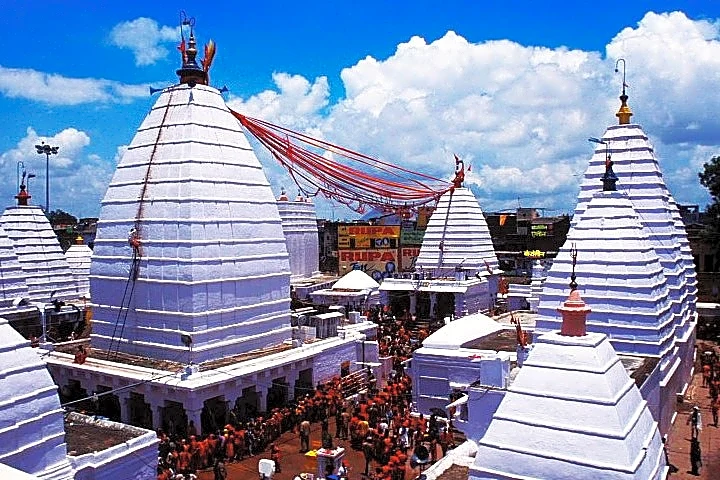India, often revered as Deva Bhumi or the “Land of Gods,” is a spiritual haven dotted with many holy temples that show its strong faith and religious heritage. Among these sacred sites, the Baidyanath Temple in Deoghar, Jharkhand, stands as a beacon of devotion, drawing millions of pilgrims and travelers each year. The Baidyanath Temple in Deoghar is one such holy place, dear to those who love Lord Shiva. Deoghar, meaning home of gods, is a calm spot in Jharkhand, known for its spiritual air and holy sites. Past its hills and streams, the Baidyanath Temple, one of twelve Jyotirlingas, stands as a sign of Shiva’s light. Join us on a journey to explore the Baidyanath Temple, its history, architecture, spiritual significance, and everything you need to plan your visit.
History of Baidyanath Temple
The Baidyanath Temple, named Baba Baidyanath Dham, holds tales from long ago, full of devotion. Built around 1516 by Gidhaur kings, it keeps a Kamna Linga, said to answer prayers. The temple’s origins are shrouded in ancient legends, with references found in sacred texts like the Shiva Purana. According to one popular tale, the demon king Ravana, an ardent devotee of Lord Shiva, performed intense penance to please the deity. Pleased with his devotion, Lord Shiva granted Ravana a Jyotirlinga to carry back to Lanka. However, with the condition that if the linga was placed on the ground, it would remain fixed there forever.
As Ravana carried the linga, the gods, fearing his growing power, tricked him into placing it on the ground in Deoghar. The linga became rooted at the site, and thus, the Baidyanath Temple was established. This sacred Jyotirlinga is believed to be Swayambhu (self-manifested), adding to its divine significance.
Another tale says a wise man saw Shiva’s light here, making the spot special for pilgrims. In old times, enemy raiders from the west tried to harm it, but the temple stood firm, kept by kings and priests who cared. Baidyanath means healing lord, and people come to ask Shiva for health and calm, their prayers soft like morning dew.
Architecture of Baidyanath Temple
The Baidyanath Temple is a splendid example of Nagara-style architecture, a hallmark of North Indian temple design. The temple complex is an architectural marvel, characterized by its towering spire (shikhara), intricate carvings, and harmonious symmetry. The main sanctum, where the Jyotirlinga is enshrined, is the focal point of the complex, radiating a sense of divine energy.
Twenty-one small shrines stand near, for Shakti, Vishnu, and Hanuman, with stone walls showing gods’ stories. The stones, worn but strong, have carvings of Shiva dancing or sitting still, full of awe. A tall gate at the front, a gopuram, has flowers and leaves carved neat. By the temple, Sivaganga Lake, a quiet pond, is for holy baths, its water clear like faith. The stone halls and open spaces feel sacred, a place where hearts find peace, pure and true.
Spiritual Significance
The Baidyanath Temple holds immense spiritual importance for Hindus worldwide. As one of the twelve Jyotirlingas, it is believed to be a direct manifestation of Lord Shiva’s divine energy.
People come to pray for health, wealth, or freedom from woes, their hearts full of hope. The air hums with holy words and smells of incense, making a sacred place to pray. The Kamna Linga, known to grant wishes, brings pilgrims who give milk, bilva leaves, and flowers, sure Shiva hears their call. In July, the Shravani Mela sees many Kanwariyas, in orange robes, walk 105 kilometers from Sultanganj to pour Ganga water on the linga. Their chants and aartis at dawn and dusk fill the temple with a holy spark, a mark of deep faith.
Things to Do at Baidyanath Temple
Visiting the Baidyanath Temple is a deeply enriching experience, offering a blend of spirituality, culture, and exploration. Seeing aartis, where priests sing and light lamps, touches the heart, tying it to the divine. Walking the grounds shows small shrines, each with a god and tale, teaching old Hindu ways. Pilgrims can do rites like Rudra Abhishekam, pouring milk and water on the linga, a clean act of faith. Sivaganga Lake, by the temple, calls for holy baths, its still water holding the temple’s calm. Talking to priests, who share old stories, brings the past close, a gift for those who hear. In Deoghar’s markets, prasad like peda sweets and rudraksha beads join visitors to the temple’s sacred life.
Visiting Information for Baidyanath Temple, Deoghar
How to Reach Baidyanath Temple, Deoghar
In Deoghar’s heart, the Baidyanath Temple is easy to reach by bus, taxi, or own car. Its place in the city keeps it near hotels and other holy spots.
By Air
Deoghar Airport, 12 kilometers off, has few flights from Delhi and Kolkata. Or, Ranchi’s Birsa Munda Airport, 250 kilometers away, joins Mumbai, Bangalore, and Patna. Taxis from Ranchi take you to Deoghar, a steady trip.
By Train
Jasidih Junction, 7 kilometers close, links to Kolkata, Delhi, Patna, and Mumbai with trains like the Howrah-Deoghar Express. Autos and taxis at Jasidih carry people to the temple quick.
By Road
Deoghar connects to Ranchi, Patna, Kolkata, and Dhanbad by state or private buses. Taxis or own cars make it simple, and in Deoghar, rickshaws or a short walk reach the temple from nearby stays.
Nearby Attractions
Around Baidyanath Temple, Deoghar has other holy and quiet places. Naulakha Mandir, 2 kilometers off, is a Radha-Krishna shrine, built in 1940, with a high 146-foot gate, soft with peace. Trikuti Temple, 10 kilometers away, honors Bhadrakali by wood apple trees, a green hill spot. Sivaganga Lake, next to the temple, is sacred for baths, its water clear like faith. Basukinath Temple, 50 kilometers far, another Shiva shrine, pairs with Baidyanath for Kanwariyas. Tapkeshwar Hill, 5 kilometers out, gives wide views and a small Shiva shrine, a calm walk for thought.
Final Thoughts
The Baidyanath Temple in Deoghar is more than a place of worship; it is a spiritual and cultural landmark that embodies the essence of India’s divine heritage. For those who pray to Shiva or seek India’s sacred past, this shrine gives a deep path. Plan your journey to this sacred abode and immerse yourself in the divine grace of Lord Shiva.











